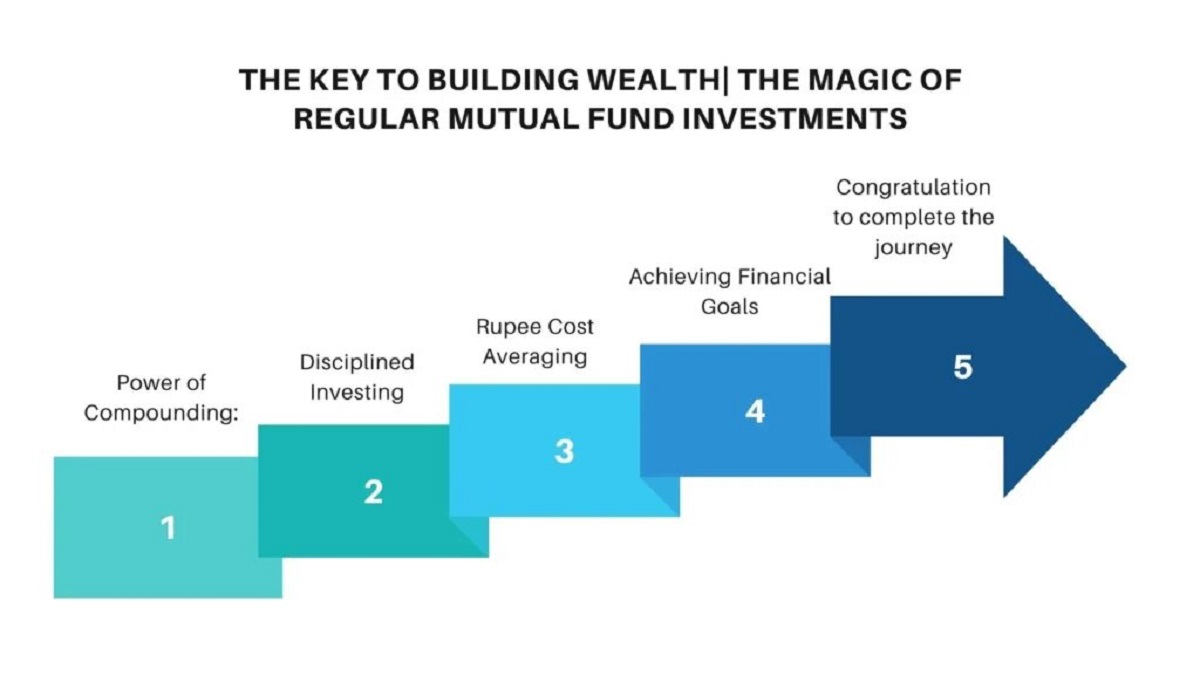Introduction
Building wealth through investments is a goal shared by many individuals. Whether you are looking to secure your financial future, fund your dream retirement, or achieve financial independence, investing can play a crucial role in helping you realize those aspirations.
Investing is the process of allocating your money into various assets with the expectation of generating a profit or return over time. It involves taking calculated risks, making informed decisions, and understanding the dynamics of the financial markets.
However, investing can be a complex and daunting endeavor, especially for those new to the field. With a plethora of investment options available, it’s important to have a solid understanding of the fundamental principles and strategies that can pave the way to building wealth.
In this article, we will explore the keys to building wealth through investments. From understanding investment basics to developing a comprehensive investment strategy, diversifying your portfolio, and managing risks, we will cover the essential elements that can help you achieve your financial goals.
It’s important to note that investing is not a get-rich-quick scheme, but rather a long-term commitment. It requires patience, discipline, and a willingness to navigate through market fluctuations. By learning the keys to successful investing, you can increase your chances of accumulating wealth over time.
We will also delve into different investment vehicles such as stocks, bonds, real estate, mutual funds, exchange-traded funds (ETFs), cryptocurrencies, and alternative assets. Each of these options has its unique characteristics and potential rewards, along with associated risks.
Additionally, we will discuss the importance of regularly monitoring and reviewing your investments to ensure they align with your goals, as well as the benefits of seeking professional advice from financial advisors or investment professionals.
By the end of this article, you will have a solid foundation to embark on your investment journey and make informed decisions that can propel you towards financial success. So let’s dive in and explore the keys to building wealth through investments.
Understanding Investments
Before diving into the world of investments, it is crucial to have a clear understanding of what it means to invest your hard-earned money. In simple terms, investing involves putting your money into various assets with the expectation of earning a return or profit over time.
Investments can take many forms, including stocks, bonds, real estate, mutual funds, ETFs, cryptocurrencies, and alternative assets. Each investment vehicle comes with its own characteristics, risk levels, and potential for returns.
Investing is different from saving. While saving involves keeping your money in low-risk and easily accessible accounts such as savings accounts or certificates of deposit (CDs), investing requires assuming some degree of risk in exchange for the potential of higher returns.
One of the key principles of investing is the concept of compounding. Compounding refers to the ability of an asset to generate earnings, which are then reinvested to generate more earnings over time. This snowball effect can significantly accelerate the growth of your investment portfolio.
Another fundamental concept in investing is the risk-return tradeoff. Generally, higher-risk investments have the potential for higher returns, while lower-risk investments tend to offer lower returns. It’s essential to assess your risk tolerance and investment timeline to determine the appropriate level of risk you are comfortable with.
Moreover, investments are influenced by various factors such as economic conditions, market trends, geopolitical events, and company performance. Staying informed about these factors and their potential impact on your investments is crucial for making informed decisions.
Understanding the basics of investment jargon is also necessary. Terms such as stocks, bonds, dividends, interest rates, capital gains, and portfolio allocation are common in the investment world. Taking the time to educate yourself about these terms will empower you to navigate the investment landscape with confidence.
Lastly, it’s crucial to establish realistic expectations when it comes to investing. While it’s natural to desire high returns, it’s important to remember that investing is a long-term strategy. It’s best to approach investments with a long-term mindset, focusing on the accumulation of wealth over time rather than short-term market fluctuations.
By understanding the fundamental principles of investments and familiarizing yourself with the different investment options available, you will be better equipped to make informed decisions and set the foundation for building wealth through investments.
Setting Financial Goals
Setting clear financial goals is a crucial first step in building wealth through investments. Your goals will serve as a roadmap, guiding your investment decisions and helping you stay focused on your long-term objectives. When setting financial goals, it’s important to consider both short-term and long-term aspirations.
Start by identifying your specific financial objectives. Do you want to retire comfortably? Purchase a home? Fund your children’s education? Travel the world? By clearly defining your goals, you can tailor your investment strategy to align with them.
Once you have identified your financial goals, set a realistic timeline for achieving them. Breaking down your goals into short-term, medium-term, and long-term objectives can help you track your progress and make necessary adjustments along the way.
It’s important to attach a dollar amount or specific target to each goal. For example, if your goal is to retire comfortably, determine how much you will need to save for retirement and develop an investment plan to achieve that target.
In addition to quantifying your financial goals, it’s essential to prioritize them. Determine which goals are most important to you and focus your investment efforts accordingly. This prioritization will help you allocate your resources effectively and maximize your chances of success.
Consider the level of risk you are willing to take to achieve your goals. Higher-risk investments may offer potentially higher returns but also come with greater volatility and potential for losses. Evaluate your risk tolerance and ensure that your investment strategy aligns with your comfort level.
Regularly reassess your financial goals as your circumstances change. Life events such as marriage, the birth of a child, or a career change may require adjustments to your investment strategy. Stay flexible and adapt your plans as needed to keep yourself on track towards your financial objectives.
Remember that financial goals are not set in stone. As you progress along your investment journey, you may discover new opportunities or revise your objectives. Be open to refinement and modification of your goals as you acquire more knowledge and experience in the world of investments.
By setting clear, quantifiable, and achievable financial goals, and regularly reviewing and adjusting them as necessary, you will create a solid framework for building wealth through investments. These goals will serve as the foundation for developing your investment strategy and making informed decisions along the way.
Developing an Investment Strategy
Developing a well-defined investment strategy is essential for achieving your financial goals and building wealth over time. An investment strategy serves as a blueprint that outlines the approach you will take to allocate your resources and make investment decisions.
Start by assessing your risk tolerance and investment timeline. These factors will help determine the appropriate asset allocation for your portfolio. Generally, younger investors with a longer time horizon can afford to take on more risk, while older investors nearing retirement may opt for a more conservative approach.
Consider your financial goals and the level of return you aim to achieve. Different investment options have varying levels of risk and potential returns. Determine the balance of risk and reward that aligns with your objectives and risk tolerance.
Diversification is a key component of a successful investment strategy. Spreading your investments across different asset classes, industries, and geographical regions can help reduce the overall risk in your portfolio. This diversification can protect your investments from market fluctuations and increase the potential for consistent returns.
Regularly review your investments and make necessary adjustments to your strategy. Stay informed about market trends and economic conditions that may impact your portfolio. By monitoring your investments, you can identify opportunities, manage risks, and rebalance your portfolio when needed.
Consider your investment time horizon when making investment decisions. Short-term investments may focus on generating immediate returns, while long-term investments can capitalize on compounding and withstand short-term market volatility.
Choose investments that align with your interests, knowledge, and values. Investing in areas that you understand can help you make more informed decisions and feel more connected to your investment portfolio.
Keep your emotions in check when making investment decisions. Avoid succumbing to short-term market fluctuations and making impulsive decisions based on fear or greed. Stick to your investment strategy and stay focused on your long-term goals.
Regularly assess and adjust your investment strategy as your goals and circumstances evolve. Periodically reevaluate your risk tolerance, time horizon, and financial objectives to ensure that your strategy remains aligned with your needs.
Consider seeking professional advice from trusted financial advisors or investment professionals. They can provide valuable insights, help you navigate complex investment landscapes, and offer guidance tailored to your specific needs and goals.
By developing a well-thought-out investment strategy, incorporating diversification, staying informed, and regularly reviewing and adjusting your approach, you can increase your chances of building wealth through investments and achieving your long-term financial goals.
Diversifying Your Portfolio
Diversification is a fundamental principle in investing that involves spreading your investment holdings across different asset classes, industries, and geographical regions. This strategy aims to reduce the overall risk of your portfolio and increase the potential for consistent returns.
One of the main benefits of diversification is that it helps protect your investments from the adverse impact of a single investment or market sector. By investing in a variety of assets, you can mitigate the risk of significant losses if one investment performs poorly.
A well-diversified portfolio typically includes a mix of stocks, bonds, real estate, and other asset classes. The specific allocation will depend on your risk tolerance, investment goals, and personal circumstances.
Investing in different industries is also crucial for diversification. Industries can experience varying degrees of growth and volatility depending on economic conditions and market trends. By spreading your investments across industries, you can potentially offset losses in one sector with gains in another.
Geographical diversification involves investing in different regions or countries. Economic and political conditions can vary significantly across the globe, and by diversifying geographically, you can reduce the impact of localized events on your portfolio.
Another aspect of diversification is investing in various types of investment instruments within each asset class. For example, within the stock market, you can diversify by investing in large-cap stocks, small-cap stocks, and international stocks. This diversification allows you to capture different growth opportunities and reduce the risk associated with a particular investment.
Additionally, diversification can extend to the duration and quality of your bond investments. By holding bonds with different maturities and credit ratings, you can balance potential interest rate fluctuations and credit risks.
While diversification can help reduce risk, it is important to note that it does not guarantee a profit or eliminate all investment risk. Market conditions can affect all investments to some extent, and diversification cannot shield you from market downturns.
Regularly review and rebalance your portfolio to ensure it remains diversified. Over time, some investments may outperform others, causing your portfolio to become imbalanced. Rebalancing involves selling investments that have become overweight and reinvesting the proceeds into underperforming assets, restoring your desired asset allocation.
It’s important to note that diversification does not eliminate the need for thorough research and due diligence. Each investment should be analyzed based on its own merits and aligned with your investment strategy and risk tolerance.
By diversifying your portfolio, you can spread your investment risk and increase your potential for consistent returns. It is a strategy that can help you weather market fluctuations and position yourself for long-term financial success.
Minimizing Investment Costs
When it comes to building wealth through investments, minimizing costs is an important aspect that can significantly impact your overall returns. By being mindful of investment costs and adopting strategies to minimize them, you can maximize the growth of your portfolio.
One key cost to consider are fees associated with investment products and services. These fees can include management fees, expense ratios, trading commissions, and administrative charges. It’s essential to research and compare different investment options and providers to ensure you are getting the best value for your money.
One way to minimize costs is to opt for low-cost investment options such as index funds or exchange-traded funds (ETFs). These funds are designed to track a specific market index and typically come with lower expense ratios compared to actively managed funds. By investing in low-cost funds, you can minimize the impact of ongoing fees on your portfolio’s performance.
Another cost-saving strategy is to consider the frequency of trading. Excessive trading can lead to increased transaction costs, including commission fees. It’s important to establish a long-term investment strategy and avoid unnecessary trading activity based on short-term market fluctuations.
For those who prefer actively managed funds or individual stock picking, it’s important to assess the potential returns compared to the associated expenses. While active management can provide the opportunity for higher returns, it often comes with higher management fees. Consider the track record and expertise of the fund manager or conduct thorough research when selecting individual stocks to increase the chances of a positive return on investment.
Take advantage of tax-efficient investment strategies to minimize tax-related costs. Consider utilizing tax-advantaged accounts such as individual retirement accounts (IRAs) or employer-sponsored retirement plans to benefit from tax deductions or tax-free growth. Additionally, be mindful of the tax implications of buying and selling investments and consider holding investments for longer periods to qualify for more favorable tax rates.
Automate your investments to minimize the impact of market timing and emotional decision-making. Set up automatic contributions to your investment accounts to ensure consistent savings and avoid making impulsive investment decisions based on short-term market fluctuations.
Regularly review your investment portfolio to identify and eliminate underperforming investments. Holding on to investments that consistently underperform can lead to unnecessary costs in terms of opportunity costs and ongoing management fees. Reallocate those funds into investments with better growth potential or lower costs.
Finally, consider the total cost of ownership when evaluating different investment options. This includes not only the direct costs mentioned above, but also indirect costs such as bid-ask spreads, custodial fees, and account maintenance fees. Understanding and comparing the total cost of ownership can help you make more informed decisions when selecting investments.
By being mindful of investment costs and adopting strategies to minimize them, you can maximize the growth of your investment portfolio. Minimizing costs can increase your potential for higher returns and ultimately contribute to building long-term wealth.
Risk Management
Managing risk is a critical component of successful investing. While investing inherently involves some level of risk, understanding and effectively managing risks can help protect your portfolio and increase your chances of achieving your financial goals.
One key principle of risk management is diversification, as discussed earlier. By spreading your investments across different asset classes, industries, and geographical regions, you can reduce the impact of a single investment or sector on your portfolio. Diversification helps mitigate the risk of significant losses by ensuring that potential losses in one investment can be offset by gains in others.
It is also important to assess your risk tolerance when developing your investment strategy. Your risk tolerance is a measure of how comfortable you are with taking on risk and experiencing potential losses. Knowing your risk tolerance will help you determine the appropriate allocation of investments and ensure that you are not exposing yourself to more risk than you can handle.
Additionally, understanding the specific risks associated with different investment types is crucial. Each investment carries its own set of risks, and being aware of these risks will help you make informed decisions. For example, stocks are subject to market fluctuations, while bonds can be affected by changes in interest rates. Real estate investments may be influenced by factors such as location, demand, and economic conditions.
Timing the market can be a risky endeavor. Trying to predict short-term market movements and making frequent changes to your investment holdings in response to market conditions can be counterproductive. Instead, adopt a long-term investment approach and focus on the fundamentals of investing. Over time, the market tends to reward disciplined and patient investors.
Regularly reviewing and rebalancing your portfolio is essential for managing risk. Market conditions and the performance of different investments can change over time, and your portfolio may become imbalanced. Rebalancing involves selling overperforming assets and reallocating funds to underperforming or more promising investments. This practice helps maintain the desired risk profile of your portfolio.
Stay informed about market trends, economic conditions, and geopolitical events that may impact your investments. Being aware of external factors that could influence your portfolio will help you make more informed decisions and adjust your investment strategy if necessary.
Consider the impact of inflation on your investments. Inflation erodes the purchasing power of money over time, so it’s important to ensure that your investment returns outpace inflation. Investing in assets that historically provide a hedge against inflation, such as stocks and real estate, can help protect your portfolio from the effects of inflation.
Finally, managing risk includes having an emergency fund. An emergency fund is a separate savings account that can cover unexpected expenses or provide a financial safety net in case of income loss. Having this cushion can help alleviate the need to sell investments at unfavorable times or dip into long-term investments during challenging periods.
By implementing effective risk management strategies such as diversifying your portfolio, understanding and assessing risk tolerance, staying informed, regularly reviewing your portfolio, and maintaining an emergency fund, you can navigate the ups and downs of the market and protect your investments for the long term.
Investing in Stocks
Investing in stocks is one of the most common and popular ways to build wealth over the long term. Stocks represent ownership in a company, and by purchasing shares of publicly traded companies, investors can participate in their growth and profit potential.
There are several key aspects to consider when investing in stocks. Firstly, it is important to conduct thorough research on the companies you are interested in. Analyze their financial health, growth prospects, competitive advantage, and management team. This research will help you make informed decisions and identify stocks that align with your investment goals.
Understanding your risk tolerance is crucial when investing in stocks. Stocks can be subject to significant price fluctuations, and investments in individual companies carry higher risks compared to diversified investments. Assess your ability to withstand market volatility and select stocks accordingly.
Diversification is also essential when investing in stocks. Rather than putting all your eggs in one basket, consider building a well-diversified portfolio by investing in a range of companies across different industries. This diversification can help mitigate the risk associated with individual stock performance and increase the potential for consistent returns.
Consider whether you want to invest in individual stocks or utilize mutual funds or ETFs. Investing in individual stocks requires diligent research and monitoring, whereas mutual funds and ETFs allow you to invest in a diversified portfolio of stocks without the need for individual stock selection.
Regularly monitoring your stock investments is important. Stay informed about company news, earnings reports, and industry trends that may impact the performance of your holdings. This information can help you make informed decisions about buying, selling, or holding your stocks.
Investing in stocks requires a long-term perspective. Stocks are known to exhibit volatility in the short term, but historically, they have outperformed other asset classes over longer time frames. Resist the urge to react to short-term market fluctuations, and focus on the fundamentals of the companies you have invested in.
Stock dividends can be an additional source of income. Some companies distribute a portion of their profits to shareholders in the form of dividends. Dividend stocks can provide income and potentially offer a more stable return on investment, particularly for income-oriented investors.
Finally, consider the importance of ongoing education when investing in stocks. Stay up to date with financial news, investment strategies, and market trends. Continuously improving your knowledge about stocks and investing can help you make better-informed decisions and improve your overall portfolio performance.
Investing in stocks can offer attractive long-term growth potential, but it entails risks. By conducting thorough research, diversifying your portfolio, staying informed, monitoring your investments, and adopting a long-term perspective, you can navigate the stock market and have the opportunity to build wealth over time.
Investing in Bonds
Investing in bonds is a popular choice for investors seeking a more conservative approach to building wealth. Bonds are debt securities issued by governments, municipalities, and corporations to raise capital. When you invest in bonds, you are essentially lending money to the issuer in exchange for regular interest payments and the return of your principal amount at maturity.
Bonds are considered lower-risk investments compared to stocks because they offer a fixed income stream and have a predetermined maturity date. However, it’s important to note that not all bonds carry the same level of risk. Government bonds are generally seen as the safest since they are backed by the full faith and credit of the government, while corporate bonds and municipal bonds may carry higher risk depending on the financial health of the issuer.
When investing in bonds, there are several key factors to consider. The first is the bond’s credit quality, typically represented by a rating agency. These ratings provide insights into the issuer’s ability to meet its financial obligations. Higher-rated bonds tend to offer lower yields but are considered safer investments.
Yield is another important consideration. The yield on a bond represents the return an investor can expect to earn based on its purchase price and interest payments. Bonds with higher yields often come with higher risk, such as those issued by lower-rated entities or with longer maturities.
Maturity is also a critical factor to assess. Maturity refers to the length of time until the bond’s principal is repaid. Shorter-term bonds generally offer lower yields but greater liquidity and lower interest rate risk. Longer-term bonds may offer higher yields but come with greater interest rate risk as they are more sensitive to changes in market interest rates.
Bond prices can fluctuate in response to changes in interest rates. When interest rates rise, bond prices tend to fall, and vice versa. Understanding the relationship between bond prices and interest rates is crucial for making informed decisions when investing in bonds.
Consider the tax implications of bond investments. Certain types of bonds, such as municipal bonds, can offer tax advantages by providing tax-exempt interest income at the federal or state level. Understanding the tax treatment of your bond investments can impact your after-tax returns.
Diversification is important when investing in bonds as well. Consider diversifying across different issuers, maturities, and sectors to minimize concentration risk and maximize the potential for consistent returns.
Finally, keep in mind that investing in bonds requires a long-term perspective and patience. Bonds are typically lower-risk investments that generate income over time, making them suitable for income-oriented investors and those with a lower risk tolerance.
Investing in bonds can provide stability, regular income, and potential capital preservation. By considering factors such as credit quality, yield, maturity, interest rate risk, tax implications, and diversification, investors can make informed bond investment decisions and contribute to their long-term wealth-building goals.
Investing in Real Estate
Investing in real estate can be a lucrative avenue for building wealth and diversifying your investment portfolio. Real estate investments can offer various opportunities, including rental income, property appreciation, and potential tax advantages. However, it’s important to understand the factors involved and develop a well-thought-out strategy before venturing into real estate investing.
One of the main advantages of investing in real estate is the potential to generate rental income. Owning a property and renting it out to tenants can provide a steady stream of cash flow. The income from rental properties can help cover mortgage expenses, maintenance costs, and other expenses while potentially leaving room for profit.
Property appreciation is another benefit of real estate investing. Over time, real estate properties have historically increased in value, allowing investors to build equity and potentially sell the property at a higher price in the future. However, it’s important to note that property values can fluctuate based on market conditions and location-specific factors.
Tax advantages are also available to real estate investors. Deductions such as mortgage interest, property taxes, and depreciation can help offset rental income, reducing the taxable portion. It’s advisable to consult with a tax professional to understand the specific tax benefits and implications in your jurisdiction.
Real estate investments offer the potential for diversification in your investment portfolio. Real estate values are generally not highly correlated with stock market performance, which means that investing in real estate can help reduce the overall risk in your portfolio.
When considering real estate investments, it’s important to assess your risk tolerance and investment goals. Real estate investments come with various risks, including market fluctuations, tenant turnover, property damage, and potential vacancy. Understanding and accepting these risks is crucial in developing a successful real estate investment strategy.
Location plays a significant role in real estate investing. The desirability of the location, proximity to amenities, transportation, schools, and job opportunities can impact the potential for rental income and property appreciation. Conduct thorough market research and consider working with local experts to identify promising locations.
Financing is an essential aspect of real estate investing. Determine whether you can obtain a mortgage or leverage other financing options to acquire investment properties. Consider your ability to manage the financial obligations associated with the property, including mortgage payments, property taxes, insurance, and maintenance expenses.
Real estate investing requires active management and a commitment of time and effort. Being a landlord entails responsibilities such as finding and screening tenants, maintaining the property, and handling tenant issues and property repairs. Alternatively, you can explore the option of hiring a property management company to handle these tasks on your behalf, but it will add to your ongoing expenses.
Finally, real estate investing is generally a long-term strategy. Building wealth through real estate takes time, and properties may appreciate slowly over several years. Patience and a long-term perspective are crucial when investing in real estate.
Investing in real estate can provide a steady income stream, potential property appreciation, tax advantages, and diversification. By considering factors such as rental income potential, location, financing, active management, and a long-term mindset, you can develop a successful real estate investment strategy and work towards building wealth through real estate.
Investing in Mutual Funds
Investing in mutual funds is a popular and convenient way to gain exposure to a diversified portfolio of assets. Mutual funds pool money from multiple investors to invest in a variety of securities, such as stocks, bonds, and other assets, managed by professional fund managers.
One of the main benefits of investing in mutual funds is diversification. By investing in a mutual fund, you gain access to a broad range of securities within a single investment vehicle. This diversification helps spread risk across multiple investments and can provide a level of stability and potential for consistent returns.
Another advantage is professional management. Mutual funds are managed by experienced investment professionals who conduct research, monitor market trends, and make investment decisions on behalf of the fund. This expertise can be especially valuable for investors who may not have the time, knowledge, or inclination to manage their own portfolios.
Mutual funds offer various types tailored to different investment goals and risk profiles. For example, equity funds focus on stocks, bond funds specialize in fixed-income securities, and balanced funds maintain a mix of stocks and bonds. Selecting mutual funds that align with your investment objectives allows you to customize your portfolio to suit your needs.
Liquidity is another advantage of mutual funds. Unlike individual stocks or real estate, mutual funds can be bought or sold on any business day at the fund’s net asset value (NAV). This feature provides flexibility and easy access to your investment capital when needed.
While investing in mutual funds can provide numerous benefits, it is important to be aware of associated costs. Mutual funds charge expense ratios, which represent the annual operating expenses as a percentage of the fund’s assets. It is important to research and compare expense ratios to ensure they are reasonable and in line with the value provided by the fund.
Consider your investment horizon and risk tolerance when investing in mutual funds. Certain mutual funds may be better suited for long-term growth, while others may focus on income generation or capital preservation. Assessing your financial goals and risk tolerance will help determine the most appropriate mutual funds for your investment strategy.
When evaluating mutual funds, it is crucial to review their historical performance, investment philosophy, and investment strategy. Analyze the fund’s investment style, its top holdings, and how it has performed compared to its benchmark and peer group over various time periods. This research will help you make more informed decisions when selecting mutual funds.
Lastly, always consider your asset allocation and the overall diversification of your portfolio. Investing in a combination of different mutual funds, along with other asset classes like stocks, bonds, and real estate, can provide a well-balanced and diversified investment approach.
By investing in mutual funds, you can enjoy the benefits of diversification, professional management, convenient access, and customized investment options. Through careful research and consideration of costs, performance, and your own investment goals, mutual funds can play a vital role in building your wealth over time.
Investing in Exchange-Traded Funds (ETFs)
Exchange-Traded Funds (ETFs) have gained popularity among investors due to their flexibility, diversification, and cost-effectiveness. An ETF is an investment fund that trades on stock exchanges, similar to individual stocks. ETFs aim to track the performance of a specific index, sector, or asset class.
One of the main advantages of investing in ETFs is their diversification. ETFs typically hold a portfolio of underlying assets, such as stocks, bonds, or commodities, which provides instant diversification within a single investment. This diversification helps spread risk and can provide stability to your investment portfolio.
ETFs are designed to track a specific index, such as the S&P 500 or the Nasdaq Composite. By investing in an ETF, you gain exposure to the entire index or a targeted sector without having to purchase each individual security. This allows you to have a stake in a wide range of companies or assets, providing broad market exposure.
Investing in ETFs offers flexibility in terms of buying and selling. ETFs trade like stocks, meaning you can buy or sell shares throughout the trading day at market prices. This real-time tradability allows investors to react quickly to market changes or adjust their portfolio as needed.
ETFs are often more cost-effective compared to mutual funds. They typically have lower expense ratios due to their passive management approach. Since ETFs aim to track an index’s performance rather than actively making investment decisions, they have lower management fees. This can result in higher potential returns for investors.
Another advantage of ETFs is the ability to engage in short selling and options trading. While these strategies may introduce additional risks, they provide opportunities for investors to take advantage of market downturns or hedge their existing positions.
Liquidity is a crucial factor when investing in ETFs. Since ETFs trade on major stock exchanges, you can easily buy or sell shares at prevailing market prices. This liquidity allows investors to enter or exit their positions without significant price impact.
When considering investing in ETFs, it’s important to evaluate the ETF’s underlying index or asset class, its expense ratio, trading volume, and tracking error. Tracking error measures the divergence between the ETF’s performance and the underlying index it aims to replicate. A lower tracking error indicates a better alignment with the index’s returns.
Furthermore, investors should consider their investment goals, risk tolerance, and time horizon when selecting ETFs. There are ETFs available to suit various investment strategies, from broad market exposure to specific sectors or asset classes. Choosing the right ETFs aligned with your investment objectives is essential for optimizing your portfolio’s performance.
Lastly, regularly monitoring your ETF investments is important to ensure they align with your investment strategy. Stay informed about market trends, economic indicators, and any changes in the ETF’s underlying index. This awareness will help you make informed decisions and make necessary adjustments to your portfolio as needed.
Overall, investing in ETFs can provide diversification, flexibility, cost-effectiveness, and broad market exposure to investors. By conducting thorough research, understanding the underlying index or asset class, and regularly monitoring your investments, you can utilize ETFs as a valuable tool in building your investment portfolio.
Investing in Cryptocurrencies
Investing in cryptocurrencies has gained significant attention in recent years as these digital assets have emerged as a new investment class. Cryptocurrencies like Bitcoin, Ethereum, and many others are decentralized digital currencies that use blockchain technology for secure transactions.
One of the main attractions of investing in cryptocurrencies is their potential for high returns. Some cryptocurrencies have experienced substantial price appreciation over a short period, leading to significant profits for early investors. However, it’s important to note that the cryptocurrency market is highly volatile, and prices can fluctuate dramatically.
Decentralization is another core feature of cryptocurrencies. Unlike traditional currencies controlled by central banks or governments, cryptocurrencies operate on a decentralized network, giving users more control over their money. This decentralized nature provides an alternative to conventional financial systems and allows for peer-to-peer transactions with reduced intermediary involvement.
Investing in cryptocurrencies offers accessibility and global reach. With a digital wallet and an internet connection, individuals can invest in cryptocurrencies from anywhere in the world and engage in cross-border transactions. This accessibility opens up investment opportunities to a broader range of individuals.
When investing in cryptocurrencies, it’s essential to understand the technology and underlying fundamentals. Research the specific cryptocurrency you are interested in, including its use cases, development team, community support, and any potential regulatory or security concerns. This knowledge will help you make informed investment decisions.
Risk management is crucial when investing in cryptocurrencies. The extreme volatility of the market can lead to substantial gains or losses. It’s important to set realistic expectations, invest only what you can afford to lose, and have a well-defined risk management strategy in place. Diversifying your cryptocurrency investments and allocating only a portion of your overall portfolio to this asset class can help mitigate risk.
Security is a significant consideration when dealing with cryptocurrencies. Since cryptocurrencies are digital assets, they are susceptible to hacking and theft. Proper security measures, such as using hardware wallets or cold storage, implementing strong passwords, and being mindful of phishing attempts, are essential to protect your investments.
Regulation is an evolving aspect of the cryptocurrency market. Different countries and jurisdictions have varying approaches to cryptocurrency regulation. Stay updated with the legal and regulatory developments in your region to ensure compliance and mitigate potential risks.
Having a long-term perspective is often recommended when investing in cryptocurrencies. The cryptocurrency market is still in its early stages, and its long-term potential is yet to be fully realized. Focus on the underlying technology’s potential, market adoption, and the growth of the cryptocurrency ecosystem, rather than short-term price volatility.
Lastly, be prepared for a learning curve when investing in cryptocurrencies. Understanding concepts like wallets, private keys, exchanges, and blockchain technology requires some education. Stay informed about the latest trends, news, and developments in the cryptocurrency space to make informed investment decisions.
Investing in cryptocurrencies offers the potential for high returns and participation in a burgeoning market. By conducting thorough research, managing risk, prioritizing security, staying updated on regulations, adopting a long-term mindset, and continuously learning, you can navigate the cryptocurrency landscape and capitalize on the opportunities it presents.
Investing in Alternative Assets
Investing in alternative assets has gained popularity among investors seeking to diversify their portfolios and explore non-traditional investment opportunities. Alternative assets are investments outside of the traditional asset classes of stocks, bonds, and cash. They can include assets such as real estate, commodities, private equity, hedge funds, art, and more.
One advantage of investing in alternative assets is the potential for uncorrelated returns. Alternative assets often exhibit a low or negative correlation with traditional assets, meaning their performance may not move in sync with the stock or bond markets. This lack of correlation can provide a hedge against market volatility and enhance portfolio diversification.
Alternative assets like real estate and commodities offer tangible investments that can provide intrinsic value beyond financial returns. Real estate investments, for example, offer the potential for rental income and property appreciation, while commodities can act as a hedge against inflation and supply-demand dynamics.
Private equity and venture capital investments provide access to early-stage companies and can potentially offer high growth and investment returns. By investing in startups and private companies, investors can participate in the success of innovative businesses before they become publicly traded.
Hedge funds and private funds offer opportunities for active management and potentially higher returns. These investment vehicles employ alternative strategies and often have more flexibility in their investment approach than traditional mutual funds. However, it’s important to note that these investments often come with higher fees and higher minimum investment requirements.
Art, collectibles, and other tangible assets can also serve as alternative investments. These assets can provide aesthetic enjoyment and the potential for appreciation over time. However, investing in collectibles requires deep knowledge and understanding of the market, as well as careful consideration of factors such as condition, rarity, and historical significance.
When investing in alternative assets, it’s important to conduct thorough research and due diligence. Alternative investments can be complex, illiquid, and may carry higher risks. Understanding the asset class, its historical performance, the market dynamics, and any associated costs or restrictions is crucial to making informed investment decisions.
Liquidity is an important consideration when investing in alternative assets. Unlike stocks or bonds, some alternative investments may have limited liquidity, meaning it may be challenging to convert them into cash quickly. It’s important to assess your investment horizon and liquidity needs before committing to alternative assets.
Proper risk management is crucial in alternative asset investing. Understanding the risks associated with each alternative asset class, diversifying your investments, and considering your risk tolerance are essential. Some alternative assets may require a longer-term investment horizon to realize their full potential.
Before investing in alternative assets, consider engaging with specialized professionals or advisors who have experience in the specific asset class. Their expertise can help identify opportunities, navigate complex investment structures, and provide valuable insights into the industry trends.
Investing in alternative assets can offer unique opportunities for diversification and potential returns beyond traditional asset classes. By thoroughly researching each alternative asset, understanding the associated risks, ensuring appropriate liquidity, and seeking expert guidance when necessary, you can effectively incorporate alternative assets into your investment portfolio.
Monitoring and Reviewing Your Investments
Monitoring and reviewing your investments is a crucial task to ensure that they align with your financial goals and remain on track for success. Regularly assessing the performance of your investments and making necessary adjustments can help you maximize returns, manage risks, and adapt to changing market conditions.
One key aspect of monitoring your investments is tracking their performance. Monitor how each investment is performing in relation to your expectations and benchmarks. Review the returns generated, compare them to relevant indexes or industry averages, and assess whether they are in line with your goals. This monitoring will help you identify which investments are contributing to your portfolio’s growth and which may be underperforming.
It is important to establish a consistent timeframe for reviewing your investments. Depending on your investment goals and preferences, you may choose to review your portfolio quarterly, semi-annually, or annually. Stick to your schedule and avoid making knee-jerk decisions based on short-term fluctuations.
During the review process, consider the reasons behind any significant changes in your investments’ value or performance. Analyze market trends, economic indicators, and company-specific factors that may have influenced the results. Evaluate whether these changes are temporary or indicative of a broader trend that requires action.
In addition to performance, review the overall allocation of your portfolio. Ensure that your asset allocation is in line with your risk tolerance and investment goals. Over time, certain investments may have gained or lost value, potentially causing your portfolio to become unbalanced. Rebalancing by selling overperforming assets and reallocating funds to underperforming sectors can help maintain your desired asset allocation and manage risk.
Stay informed about news and events that may impact your investments. Be aware of developments related to the companies or industries in which you have invested. Economic indicators, policy changes, and shifts in technology or consumer behavior can all have an impact on your investments. Stay up to date to make informed decisions based on current information.
Take advantage of technology and investment tools to simplify the monitoring process. Many online platforms and financial apps offer portfolio tracking and performance analysis features. Leveraging these tools can streamline your monitoring process and provide valuable insights into your investments’ progress.
Regularly review and update your investment goals. Life circumstances and financial objectives may change over time, and your investment strategy should evolve accordingly. Assess whether your investments are still aligned with your current financial goals and make adjustments as necessary.
Consider the value of seeking professional advice. Financial advisors or investment professionals can provide objective guidance and help you make informed decisions. They can offer expertise, assist with portfolio analysis, and provide insights tailored to your specific needs and goals.
Lastly, documenting your investment reviews and decisions is essential. Keep records of your investment objectives, the rationale behind your investment choices, any adjustments, and the results of your monitoring. This documentation will help you track your progress, learn from past decisions, and make more informed choices in the future.
By regularly monitoring and reviewing your investments, you can stay informed about their performance, manage risks, and make necessary adjustments to keep your portfolio aligned with your financial goals. Stay disciplined, adaptable, and proactive in assessing your investments to maximize their potential for long-term growth.
Seeking Professional Advice
Seeking professional advice is a valuable step in managing your investments and making informed financial decisions. Financial advisors and investment professionals bring expertise, experience, and objectivity to help you navigate the complexities of the investment landscape. Their guidance can provide valuable insights and potentially enhance the performance of your portfolio.
One of the main benefits of seeking professional advice is gaining access to their knowledge and expertise. Financial advisors are trained professionals who stay up to date with market trends, investment strategies, and regulatory changes. They can provide insights into market opportunities, help you avoid common pitfalls, and provide recommendations tailored to your specific financial goals and risk tolerance.
Financial advisors can also assist in creating a comprehensive financial plan. They can help you establish clear and realistic goals, assess your current financial situation, and develop strategies to achieve those objectives. With their expertise, they can identify potential gaps in your financial plan and provide recommendations to address those areas.
Investment professionals can assist in portfolio construction and asset allocation. They have a deep understanding of different investment options and can recommend a diversified mix of assets based on your goals and risk profile. Their knowledge helps optimize your portfolio to balance risk and reward while aligning with your investment objectives.
A key advantage of working with professionals is their ability to provide an objective perspective. Emotions can sometimes cloud judgment when it comes to making financial decisions. Financial advisors can offer impartial advice and serve as a sounding board, helping you analyze options and make rational choices based on your long-term financial interests.
Financial advisors can play a crucial role in managing risk. They have experience in assessing risk tolerance and can help you determine an appropriate level of risk for your investments. They can also recommend risk management strategies to mitigate potential downsides and protect your investments from undue exposure to market downturns.
When seeking professional advice, it’s important to choose a reputable and competent advisor. Research their credentials, qualifications, and track record. Consider working with professionals who have experience in your specific investment needs or have demonstrated expertise in the relevant asset classes you wish to invest in.
Open and clear communication is crucial when engaging with professionals. Clearly articulate your financial goals, risk tolerance, and any specific needs or concerns. Providing accurate and complete information will allow the advisor to provide the most suitable recommendations tailored to your circumstances.
It’s essential to understand the cost structure associated with professional advice. Financial advisors may charge fees based on a percentage of assets under management, flat fees, or a combination of both. Be transparent in discussing fees and ensure you understand how the advisor is compensated for their services.
Lastly, keep in mind that seeking professional advice does not absolve you of the responsibility of staying informed and being actively engaged in your financial affairs. It’s important to continue learning about investing, financial planning, and understanding the decisions being made on your behalf.
By seeking professional advice, you can benefit from their knowledge, expertise, and objectivity. Financial advisors and investment professionals can assist in creating a comprehensive financial plan, optimizing your investment portfolio, managing risk, and providing insights tailored to your specific needs. Their guidance can help you make informed decisions, enhance your financial well-being, and work towards achieving your long-term financial goals.
Conclusion
Building wealth through investments requires knowledge, strategy, and ongoing effort. By understanding the fundamental principles of investing, setting clear financial goals, and developing a solid investment strategy, you can set yourself on a path toward financial success.
Investing in different asset classes, such as stocks, bonds, real estate, mutual funds, ETFs, cryptocurrencies, and alternative assets, offers opportunities for diversification and potential returns. Each asset class carries its own risks and rewards, and it’s crucial to evaluate them based on your risk tolerance and investment objectives.
Monitoring and reviewing your investments is essential to ensure they remain aligned with your goals. Regularly assessing their performance, evaluating asset allocation, and staying informed about market trends and economic factors will help you make informed decisions and adjust your portfolio as needed.
Seeking professional advice can provide valuable insights, objective guidance, and specialized expertise. Financial advisors and investment professionals can assist with creating a comprehensive financial plan, optimizing your investment portfolio, managing risk, and offering objective advice in complex financial situations.
Throughout your investment journey, it’s important to maintain a long-term perspective, exercise discipline, and stay informed about financial news and trends. Building wealth through investments is not a quick process, but with patience, consistency, and a commitment to ongoing education, you can increase your chances of achieving your financial goals.
Remember that investing involves risk, and there are no guarantees of specific outcomes. It’s essential to conduct thorough research, assess your risk tolerance, and diversify your investments to manage risk effectively.
By implementing the key principles discussed in this article and adapting them to your specific circumstances, you can position yourself for long-term financial success and work towards building wealth through investments.

























